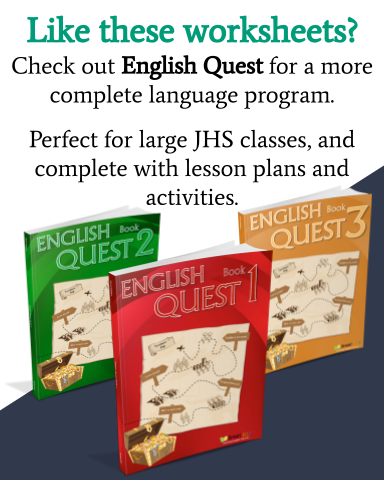Things To Consider When Selecting the Activity
When planning your lessons, you are going to want to include several activities that will be FAB (Fun Accessible Beneficial). Most of the worksheets on this site and other popular ESL sites will work fine, but they work better if you can use them as a guide, then cerate materials that work best with your particular teaching environment, language target, and students.
When planning your own activities, below are some ideas to keep in mind.
Game Focus
Is the focus language of the activity the same as, or related to the target language of the lesson?
You should think of your target first and then decide what activity best compliments its use. Trying to force a game to adopt the target language, just because you know the game is fun can lead to students becoming confused about the focus. Which is more important, the game or the Target Language?
Ease of Use
Try and explain the game to one of the other teachers first. If they don’t understand the game, then chances are the students won’t either. On occasion, when I had created a game that I thought might be overly challenging, I would ask a few of the teachers to try out the activity with me. The other teachers found it interesting to play a game and see what I was doing in my lessons, and I could see where possible failures in the activity may arise.
Ease of Explanation
In your mind, the actual gameplay and target of the game may be relatively easy, but how easy is it to get the students to understand what you want them to do?
- Practice explaining the game to your JTE.
- Think of how you will incorporate demoing
- Think of how you will incorporate instructing
- Think of how you will incorporate modeling
- Also, allow for extra time when you first explain the game and remember it will only get easier after that.
Level
Of course, make sure that the language and vocabulary that you are using in the game are appropriate to that of the students. This shouldn’t be a problem if you have followed the point on game focus, and in turn, if you have chosen an appropriate target. But be careful!
Cheating
Before bringing your game to the classroom, try to think of all the ways that your students can ‘cheat’ the activity. If there’s a way, they will find it! Try to create rules to prevent this from happening. Especially important in competition games as the students can get upset and blame you if other teams start cheating to win!
Time
Timing is everything in activities. First, plan how long you think it will realistically take you to introduce and explain the activity. Then set how long you will allow students to complete the activity. If the activity is open-ended, or you have a wide range of abilities, use a stopwatch to give a definite ending to the game. Also, give a running countdown (in English) of how long the students have left. Then as part of your array of Classroom Gestures and Language, get the class to stop doing the activity. (I choose to imitate a loud buzzing sound, but of course, having something that makes an interesting noise will work better for younger children.)
Boredom Factor
If you find a game that works, don’t kill it by overplaying it. A game that gets the students ‘super bouncy’ can be a great way to lighten a target or lesson that you feel may not be that fun. It can also be good as a kind of present to the students and something that they can look forward to.
If you play the same game over and over, it will lose its charms pretty quickly, and as they say ‘Variety is the spice of life’ Also having that lesson from time to time that doesn’t really go that well, can make the lessons that are more fun, seem even more interesting!
Language and Contextualization
Make sure that the language is appropriate to the students’ age range and lifestyle. Include activities appropriate to their life and include the names of bands and famous people that they know. Teaching the sentence ‘I was fired yesterday!’





